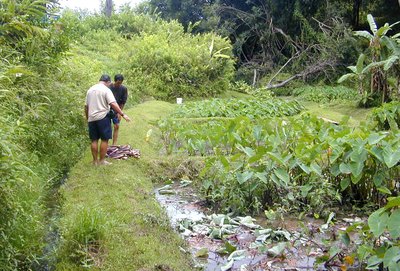Taro
|
|
| Taro | ||||||||||||||
|---|---|---|---|---|---|---|---|---|---|---|---|---|---|---|
| Missing image Colocasia_esculenta_5.jpg | ||||||||||||||
| Scientific classification | ||||||||||||||
|
Taro (from Tahitian), more rarely kalo (from Hawaiian), is a tropical plant grown primarily as a root vegetable for its edible corm, and secondarily as a leaf vegetable. Its flowers are more rarely eaten. Taro is closely related to elephant ear and Caladium, plants commonly grown as ornamental plants. The genus Colocasia contains about 8 species distributed throughout Polynesia and Indo-Malaysia (Wagner, Herbst, and Sohmer, 1999).
Taro is a traditional staple in many tropical areas of the world, and is the base for making poi in Hawai‘i. The plant is actually inedible if ingested raw because of raphides in the plant cells. Severe gastrointestinal distress can occur unless the plant is properly processed first.
Taro can be grown in pond fields or in upland situations where watering is supplied by rainfall or by supplemental irrigation. Some varieties of taro can also be grown away from the tropics, in places such as Korea and Japan. In Korea, the corm is stewed and the leaf stem is stir-fried. The taro corm is called sato-imo (里芋) in Japanese and supermarket varieties range from about the size and shape of a brussel sprout to longer, larger varieties the size of an adult male's fist. Taro is typically boiled, stewed, or sliced and fried as tempura. The small round variety is peeled and boiled, sold either frozen, bagged in its own liquids, or canned. In China, taro is often used as an ingredient in niangao, a kind of dense cake made from glutinous rice flour eaten during Chinese New Year. In Africa, this plant is typically called "taro cocoyam".
Taro production in Hawai‘i
Taro is usually grown in pondfields called lo‘i (in Hawaiian). Typical upland varieties presently grown in Hawai‘i are Lehua maoli and Bun long, the latter widely known as Chinese taro. Bun long is used for making taro chips. Dasheen (also called "eddo") is another "dryland" variety of C. esculenta grown for its edible corms or sometimes just as an ornamental plant.
The picture below shows several small lo‘i in Maunawili Valley on O‘ahu. The ditch on the left in the picture is called an ‘auwai and supplies diverted stream water to the lo‘i or pondfields. Cool flowing water yields the best crop. Some of the taro plants in the foreground have been harvested and the caretakers are preparing to replant the huli stacked at their feet. These are the top portion of the corm with a short piece of bladeless leafstem.
The Hawai'i Agricultural Statistics Service puts the 10-year median production of taro in the Hawaiian Islands at about 6.1 million pounds (2,800 t). However, 2003 taro production in Hawai'i was only 5 million pounds (2,300 t) an all-time low. The previous low, reached in 1997, was 5.5 million pounds (2,500 t). Urbanization has driven down harvests from a high of 14.1 million pounds (6,400 t) in 1948. But more recently the decline has resulted from pests and diseases. A non-native apple snail (Pomacea canaliculata) is a major culprit in the current crop decline. Also, a plant rot disease, traced to a newly identified species of the fungal genus Phytophthora, now plagues crops throughout the state. Although pesticides could control both pests to some extent, pesticide use in the pondfields is barred because of the clear opportunity for chemicals to quickly migrate into streams and then the ocean (Viotti, 2004).

